“A fifteen foot ship that weighs only sixty pounds and carries a thousand pounds of load over rough water; which is safe, which travels easily faster than four miles an hour ; which never leaks; and which lasts, with ordinary care, for twenty years-needs to be made by a man (or woman) who is passionately fond of being being honest.
William Boardman Lovers of the Woods, 1901
What is it about a guideboat that gives it such extraordinary performance? It combines great carrying capacity and speed in a very light package.
The innovators who devised the guideboat took their inspiration from the Old World wherry. This Old World rowboat has a flat bottom and ribs taken from tree roots. It has a squared off stern, or transom. Originally guideboats had the same squared-off stern. It is said that Caleb Chase of Newcomb, NY changed guideboat construction to a double-ender in 1870.
A structural engineer would analyse a guideboat as follows: the bottom board provides a platform to fasten the ribs and stems. The planking, of course, provides the “hole in the water” to make it a floating vessel. It also gives this “structure” stiffness. Now add to that the gunwales, strips of hardwood running along the top, or sheer, of the hull. These tie each member of the craft together to give its remarkable properties; strength, durability, speed and load carrying capacity.
I had one heck of time installing the gunwales on my first boats. Made of flat-sawn cherry, they just did not want to bend to follow the shear line of the hull. So I had to steam them using a cobbled up arrangement of a cleaner’s bag “tent” and steam from a kettle. I used a home made winch to gradually draw the gunwale down into place. It was really hard work!
Then someone told me to use quarter-sawn cherry. What a world of difference! It is easily bent to where you want it. This phote show how far the gunwale has to be bent to follow the shear line,
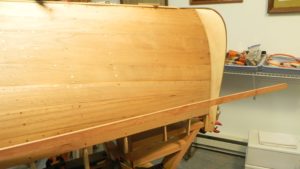
The really tricky part of the gunwale installation is getting the angle where it meets the stem just right. The gunwale meets the stem at a “rolling curve”. That means we are not dealing with a right angle here. So it is a matter of judgement and backing and forthing to get an intersection that is OK. This photo shows the gunwale being fastened down at its intersection with the stem.
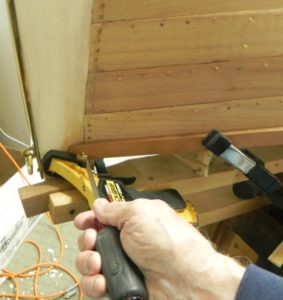
I use No. 8 X 1 1/4″ oval head screws to fasten the gunwale at each rib station.
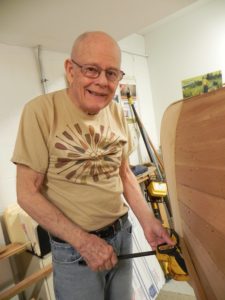
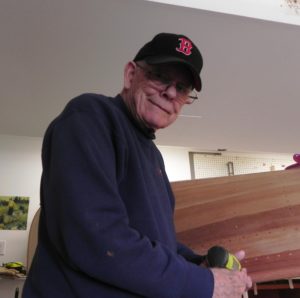
When I look down the hull with the gunwale installed I am reminded of what shipwrights call a “fair curve”. It is something in a boat builder’s head that is hard to convey to others. It is basically a harmonious, sensory pleasing curve that just “looks and feels” right. Here it is, a look down the hull with the gunwale installed.
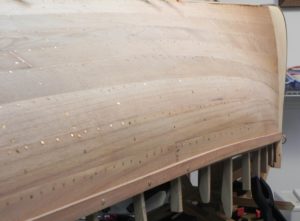
Next time this pretty little miss gets her first coats of varnish.